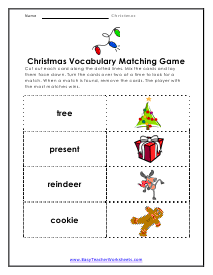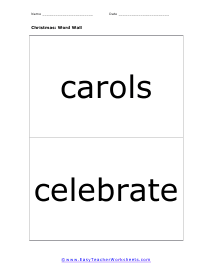These worksheets contain a number of different activities using a dedicated set of vocabulary words related to the Christmas season, including word search, fill in the blanks, scrambled words, word wall flash cards, acrostic poems, crossword puzzles, and more. The collection also includes six different packs of Bingo cards, which can be used during discussions of the topics. Last but not least, a KWHL (know, what, how, learn) diagram is included to help students pick a topic to explore in more depth. Note for instructors: In addition to the activity sheets, this collection includes writing paper decorated with Christmas and winter themes. They make great additions when asking students to prepare any written work.
Print Christmas Worksheets
Click the buttons to print each worksheet and associated answer key.




The Story Behind the Grinch
People often ask what inspired Dr. Suess to write the now-beloved story.


Decorate the Tree
Help decorate the tree by coloring the ornaments. If an ornament contains a noun, color it red. If it contains an adjective, color it green. If it contains a verb, color it blue.




The History of the Christmas Cookie
Cookies have their origins of attachment to this celebration from long ago, long before people started celebrating it the way that we do today.

Cookie Questions
Why have people historically feasted at Christmas and its preceding seasonal celebrations?

Traditions
A tradition is custom, belief, or activity that is passed on from generation to generation. Describe some of the Christmas traditions in your family.


Vocabulary Matching Game
Cut out each card along the dotted lines. Mix the cards and lay them face down. Turn the cards over two at a time to look for a match.





Legend of the Christmas Spider
Tinsel was created in Germany. It was first made from thin strips of beaten silver. One folk story about how tinsel was created is called The Christmas Spider, and it is believed to have originated in the Ukraine.


The Yule Log
Christmas has its origins in winter solstice celebrations, and Yule is the name given to the winter solstice festivals in Scandinavia. People in many cultures burn Yule logs during this season.


Word Search
Search for: carols, celebrate, December, decorations, evergreen, garland, greetings, ornament, reindeer, stocking, tradition, yuletide

Word Chop
You get a chopped salad of the words: celebrate, chimney, decorations, evergreen, garland, greetings, mittens, ornament, reindeer, stocking, workshop, yuletide


Visual Crossword
You obviously know the name of the people and animals, but the ornaments might beat you.


Alphabetic Order
Put the words sleigh, jolly, merry, yuletide, chimney, decorations, tinsel, evergreen, reindeer, and holly in alphabetic order.





Bingo Card #1
This card set includes the vocabulary words: evergreen, reindeer, tinsel, jingle, merry, holly, December, sleigh, garland, carols, gifts, workshop, wreath, chimney, jolly, elves, eggnog, ornament, mittens, stocking, greetings, yuletide, poinsettia, rooftop












What's Boxing Day
Boxing Day refers to both the day after Christmas, December 26th, and the Public Holiday which follows it, should the 26th fall on a weekend.

A Christmas War Story
In the midst of World War I, there was a Christmas truce between German and British troops in France (1914). Soldiers on both sides spontaneously began to sing carols and stopped fighting.




The Economy of Christmas
Christmas is typically the largest annual economic stimulus for many nations. Sales increase dramatically in almost all retail areas and shops introduce new products as people purchase gifts, decorations, and supplies.



What is Christmas?
Do we all know what comes on the 25th of December? That's right! Christmas! Don't we all love the snow and the beautiful lights with decorations? And the best part about the day is definitely the presents, right? But why do we celebrate it? Let's take a look! The 25th of December is a holiday to celebrate the birth of Jesus Christ as the son of God. The name Christmas is joined from "Christ" and "mass," which refers to holy mass or festival of Jesus Christ. This celebration day came just after the winter solstice, which is the shortest day of the year in the northern hemisphere. The idea was to announce that winter is not forever, and it was a form of worshipping the Sun. The day before is known as Christmas Eve. Gifts are exchanged on the Day of, and everyone gets pine trees that are decorated with bells, candles, candy canes, fairy lights, and many other things!
The History of Christmas
You won't believe this, but we encountered several surprises when we first began to learn about Christmas. Some research shows that Jesus was most likely not born on December 25 since nobody knows when his actual birthday was. Second, the early Christians did not celebrate Christmas, and it took about 300 years before the Christmas celebration was held annually. Still in shock? Don't be…Without further ado, let's dive into the fascinating history of the festival that takes the number one spot across all the generations and genders.
The Origin
The roots of Christmas can be traced back to both pagan and Roman civilizations. When it came to December, the Romans observed two different festivals. The first was Saturnalia, a two-week celebration dedicated to the god of agriculture Saturn, in the spring. Their sun deity, Mithra, was born on December 25, and they celebrated his birth on that day.
The second was the pagan nation, which burned bonfires and candles in December to ward off the darkness of the longest day of the year, which fell on December 21. The Romans, for their part, adopted this ritual into their festivities. Even as Christianity swept Europe, the Christian clergy could not prevent pagan rites and festivals from continuing unabated since no one knew the exact day of Jesus' birth; they modified a pagan ceremony to mark the occasion as a birthday party for Him.
The Ritual
For the winter solstice ceremonies, the pagan nations decked their dwellings with greenery in preparation for the upcoming springtime season. Evergreen trees retained their green color even on the coldest and darkest days, leading some people to believe that they had extraordinary powers. For Saturnalia, the Romans also decked their temples with fir trees and metal ornaments. Moreover, there is historical evidence of the Greeks adorning trees in honor of their gods.
Historically, decorating evergreen trees with candles and dried fruit dates back to Northern Europe when Germanic pagan tribes adorned evergreen trees in adoration of the deity Woden. Throughout the 1500s, the practice was officially accepted as part of the Christian religion in Germany—decking up the trees with candy, lights, and other trinkets.
Santa Claus
This Christmas custom, which St. Nicholas inspired, has Christian origins rather than pagan ones. He was born in southern Turkey about the year 280 and rose to the position of bishop in the early Christian church, where he was persecuted and imprisoned for his beliefs. Although he was born into an affluent family, he was well-known for his charity to the underprivileged in society.
There are several tales surrounding him, but the most notable is the story of how he protected three girls from being sold into slavery. Since there was no dowry to persuade a guy to marry them, their father's final choice was to arrange a marriage. Historical records show that St. Nicholas entered the house via an open window and threw riches to the family. The gold fell into a sock drying by the fire, and as a result, children began hanging stockings near their fireplaces in the hopes that St. Nicholas would drop presents into them.
Concerning his death, December 6 was designated as St. Nicholas Day. However, as time progressed, each European society developed its version of St. Nicholas. In both Swiss and German traditions, the Christkind or Kris Kringle (Christ kid) followed St. Nicholas's gift-giving mission to well-behaved youngsters worldwide.
Jultomten was a cheerful elf that traveled across Sweden in a sleigh carried by goats, distributing presents to children. Then there was Father Christmas in England and Pere Noel in France, to name a few. He was known as Sinter Klaas in the Netherlands, Lorraine, Luxembourg, Belgium, France, and portions of Germany. Klaas is a shorter form of the name Nicholas, for those who don't already know.) This is where the idea of an Americanized Santa Claus originated.
Conclusion
Christmas is all about love, joy, and peace. Many studies have shown that people are more charitable and progressively compassionate throughout the Christmas season because it is the most delightful time of year. Considering that the middle of winter has long been a time of celebration worldwide and if you're someone who eagerly waits for this extra-long holiday weekend every December, consider this blog as a parting present from us. Also, please feel free to use this fascinating history as a conversation starter at your family events (you're welcome).



